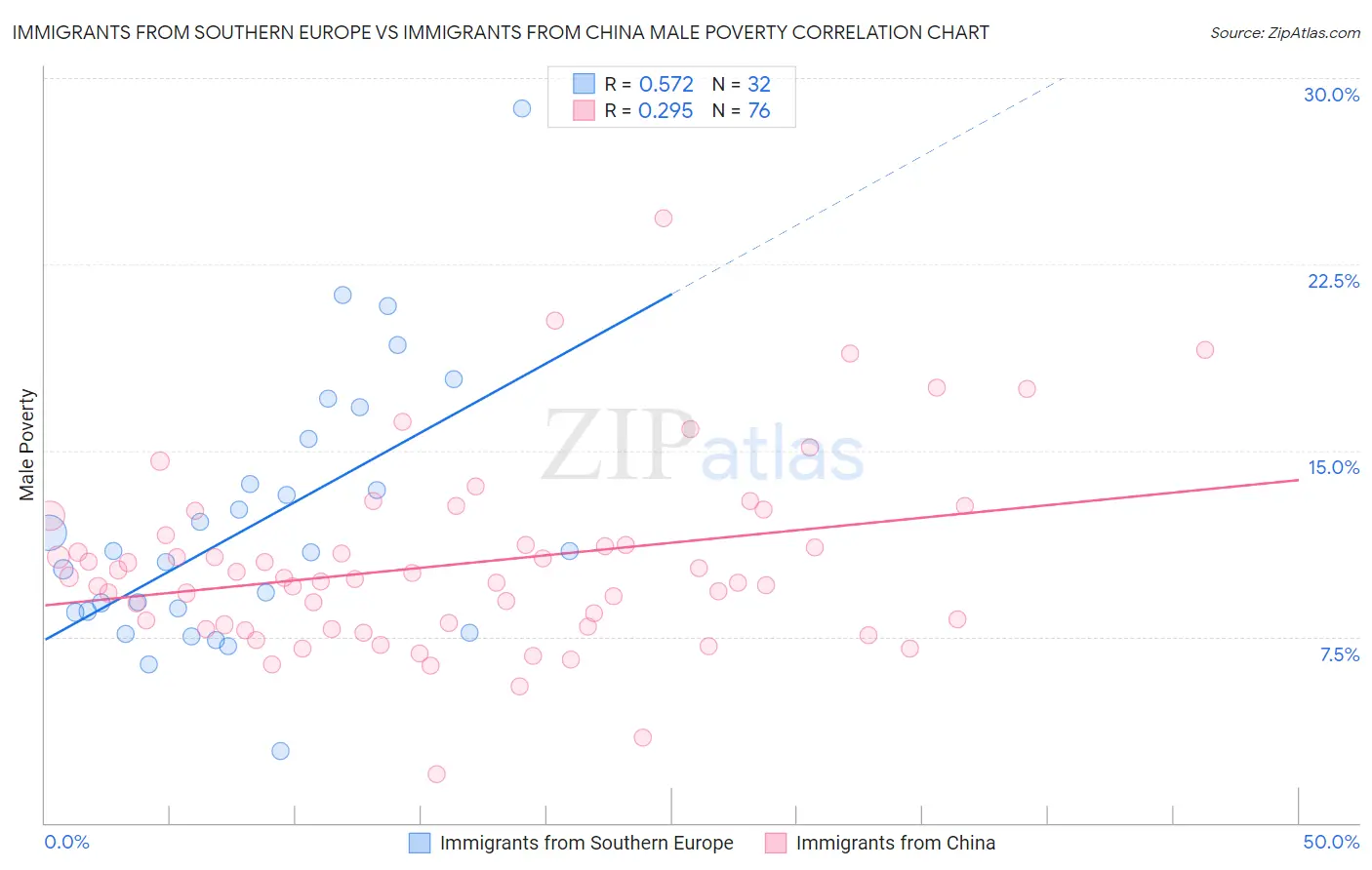Immigrants from Southern Europe vs Immigrants from China Male Poverty
COMPARE
Immigrants from Southern Europe
Immigrants from China
Male Poverty
Male Poverty Comparison
Immigrants from Southern Europe
Immigrants from China
10.5%
MALE POVERTY
91.3/ 100
METRIC RATING
106th/ 347
METRIC RANK
10.7%
MALE POVERTY
87.1/ 100
METRIC RATING
120th/ 347
METRIC RANK
Immigrants from Southern Europe vs Immigrants from China Male Poverty Correlation Chart
The statistical analysis conducted on geographies consisting of 402,406,508 people shows a substantial positive correlation between the proportion of Immigrants from Southern Europe and poverty level among males in the United States with a correlation coefficient (R) of 0.572 and weighted average of 10.5%. Similarly, the statistical analysis conducted on geographies consisting of 456,181,421 people shows a weak positive correlation between the proportion of Immigrants from China and poverty level among males in the United States with a correlation coefficient (R) of 0.295 and weighted average of 10.7%, a difference of 1.1%.

Male Poverty Correlation Summary
| Measurement | Immigrants from Southern Europe | Immigrants from China |
| Minimum | 2.9% | 1.9% |
| Maximum | 28.8% | 24.3% |
| Range | 25.9% | 22.4% |
| Mean | 12.1% | 10.4% |
| Median | 10.9% | 9.8% |
| Interquartile 25% (IQ1) | 8.5% | 7.9% |
| Interquartile 75% (IQ3) | 14.6% | 11.4% |
| Interquartile Range (IQR) | 6.1% | 3.4% |
| Standard Deviation (Sample) | 5.4% | 3.7% |
| Standard Deviation (Population) | 5.3% | 3.7% |
Demographics Similar to Immigrants from Southern Europe and Immigrants from China by Male Poverty
In terms of male poverty, the demographic groups most similar to Immigrants from Southern Europe are Laotian (10.5%, a difference of 0.010%), Portuguese (10.6%, a difference of 0.080%), Canadian (10.5%, a difference of 0.11%), Welsh (10.5%, a difference of 0.12%), and Slavic (10.5%, a difference of 0.13%). Similarly, the demographic groups most similar to Immigrants from China are Peruvian (10.7%, a difference of 0.010%), Native Hawaiian (10.7%, a difference of 0.030%), South African (10.7%, a difference of 0.070%), Immigrants from Hungary (10.7%, a difference of 0.10%), and Okinawan (10.7%, a difference of 0.11%).
| Demographics | Rating | Rank | Male Poverty |
| Slavs | 91.7 /100 | #103 | Exceptional 10.5% |
| Welsh | 91.6 /100 | #104 | Exceptional 10.5% |
| Canadians | 91.6 /100 | #105 | Exceptional 10.5% |
| Immigrants | Southern Europe | 91.3 /100 | #106 | Exceptional 10.5% |
| Laotians | 91.2 /100 | #107 | Exceptional 10.5% |
| Portuguese | 91.0 /100 | #108 | Exceptional 10.6% |
| Albanians | 90.6 /100 | #109 | Exceptional 10.6% |
| Argentineans | 90.1 /100 | #110 | Exceptional 10.6% |
| Immigrants | Argentina | 89.8 /100 | #111 | Excellent 10.6% |
| Immigrants | Turkey | 89.5 /100 | #112 | Excellent 10.6% |
| Palestinians | 89.1 /100 | #113 | Excellent 10.6% |
| Immigrants | Brazil | 89.0 /100 | #114 | Excellent 10.6% |
| Immigrants | Russia | 88.6 /100 | #115 | Excellent 10.6% |
| Sri Lankans | 88.1 /100 | #116 | Excellent 10.6% |
| Immigrants | South Eastern Asia | 88.1 /100 | #117 | Excellent 10.6% |
| Okinawans | 87.6 /100 | #118 | Excellent 10.7% |
| Immigrants | Hungary | 87.6 /100 | #119 | Excellent 10.7% |
| Immigrants | China | 87.1 /100 | #120 | Excellent 10.7% |
| Peruvians | 87.1 /100 | #121 | Excellent 10.7% |
| Native Hawaiians | 87.0 /100 | #122 | Excellent 10.7% |
| South Africans | 86.8 /100 | #123 | Excellent 10.7% |